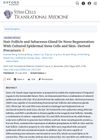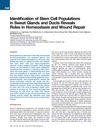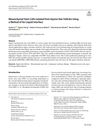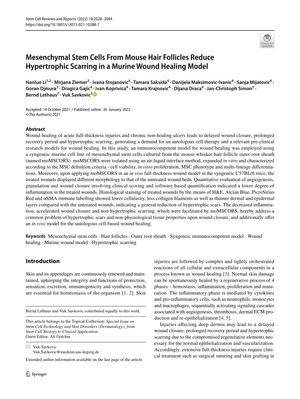TLDR Mouse stem cells from hair follicles can improve wound healing and reduce scarring.
In a study aimed at improving wound healing and reducing hypertrophic scarring, mesenchymal stem cells (moMSCORS) isolated from the outer root sheath of mouse whisker hair follicles were used in a full-thickness wound model in C57BL/6 mice. These cells were expanded and characterized in vitro, meeting the criteria for mesenchymal stem cells. When applied to wounds, moMSCORS-treated wounds exhibited less inflammation, faster wound closure, and reduced hypertrophic scarring compared to untreated wounds. This was evidenced by clinical scoring, software-based quantification, and histological staining, which showed lower cellularity, fewer collagen filaments, and thinner dermal and epidermal layers in treated wounds. The study demonstrates the potential of moMSCORS in autologous cell therapy for wound healing and offers a viable in vivo model for further research.
 44 citations
,
July 2016 in “Stem Cells Translational Medicine”
44 citations
,
July 2016 in “Stem Cells Translational Medicine” Scientists discovered that certain stem cells from mice and humans can be used to grow new hair follicles and skin glands when treated with a special mixture.
 265 citations
,
July 2012 in “Cell”
265 citations
,
July 2012 in “Cell” The study found that sweat glands contain different types of stem cells that help with healing and maintaining healthy skin.
1201 citations
,
January 2010 in “Science” Active and quiescent stem cells work together in mammals to maintain and repair tissues.
319 citations
,
November 2005 in “Proceedings of the National Academy of Sciences” Hair follicle stem cells can help repair damaged nerves.
May 2024 in “International Journal of Molecular Sciences” Mouse hair follicle stem cells can help prevent Type 1 Diabetes.
 September 2023 in “Stem cell reviews and reports”
September 2023 in “Stem cell reviews and reports” Scientists found a new, less invasive way to get stem cells from horse hair for veterinary medicine.
1036 citations
,
August 2019 in “Cells” Mesenchymal stem cells can help repair body tissues with low risk of rejection.
387 citations
,
May 2019 in “International Journal of Molecular Sciences” Adipose-derived stem cells are promising for regenerative medicine due to their accessibility, versatility, and low risk of immune rejection.
263 citations
,
February 2020 in “International journal of molecular sciences” ADSCs help in wound healing and skin regeneration but need more research for full understanding.



